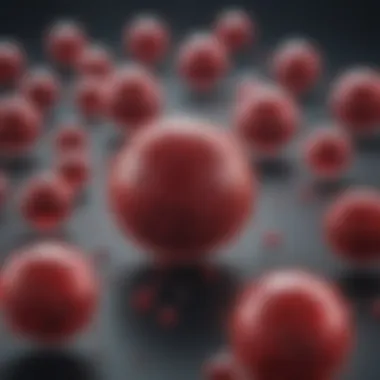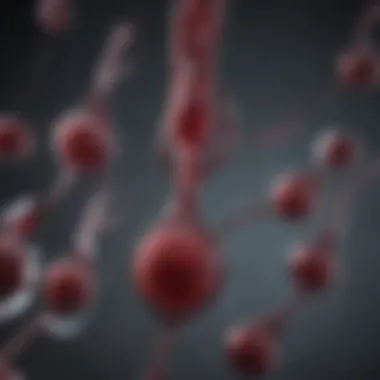Gene Therapy Innovations for Blood Disorders


Intro
Gene therapy stands at the forefront of medical innovation, particularly in the treatment of various blood disorders. As traditional therapies often fail to provide long-term solutions, gene therapy offers the promise of addressing underlying genetic issues. This technique modifies the genes responsible for causing certain conditions, which can lead to significant improvements in patient quality of life.
Blood disorders such as hemophilia, sickle cell disease, and thalassemia present considerable challenges not just for patients, but also for healthcare systems. The complexity of these diseases often requires a multifaceted approach to treatment. Thus, exploring the mechanisms of gene therapy and its applications in hematology becomes crucial.
This article aims to delve into current approaches, recent advancements, and future perspectives surrounding gene therapy for blood disorders. By examining these aspects closely, readers can gain a deeper understanding of how gene therapy is reshaping treatment landscapes in hematology.
Research Background
Overview of the Scientific Problem Addressed
Blood disorders frequently result from genetic mutations that affect the production or structure of blood cells. For instance, hemophilia is a result of mutations in genes encoding clotting factors, leading to impaired blood clotting. In sickle cell disease, a specific mutation in the hemoglobin gene causes abnormally shaped red blood cells, resulting in a host of complications. These conditions often necessitate lifelong treatment, including frequent blood transfusions and supportive therapies, which can have their own risks and complications.
Historical Context and Previous Studies
The concept of gene therapy emerged in the 1970s, fueled by advancements in molecular biology. Initial attempts in the 1990s yielded mixed results, with several high-profile projects facing setbacks due to safety concerns. However, over the last two decades, substantial progress has been made. Recent studies have demonstrated the efficacy of various gene delivery systems, including lentiviral vectors and CRISPR-Cas9 technology, which have shown promise in clinical trials.
Key milestones include the 2017 approval of onasemnogene abeparvovec for spinal muscular atrophy and the positive results from trials investigating LentiGlobin for beta-thalassemia. These successes have rekindled hope and interest in the application of gene therapy for blood disorders, laying the groundwork for further research and development.
Findings and Discussion
Key Results of the Research
Recent clinical studies have highlighted gene therapy's potential in transforming treatment paradigms. Trials involving patients with hemophilia A and B have shown that introducing functional copies of the defective gene can result in a marked reduction in bleeding episodes. In sickle cell disease, preliminary results indicate that genetic modifications can lead to the production of healthy hemoglobin, mitigating the symptoms associated with the disease.
Interpretation of the Findings
The implications of these findings extend beyond individual patient outcomes. They suggest that gene therapy can not only treat but potentially cure these genetic disorders. This represents a paradigm shift in the field of hematology, where treatment has often been more about management rather than resolution.
Gene therapy may also alleviate the financial burdens associated with long-term therapies.
"The cost-effectiveness of gene therapy could reshape healthcare expenditures for blood disorders over time."
As research continues to evolve, regulatory frameworks and ethical considerations will also be paramount in ensuring the responsible deployment of these groundbreaking therapies.
Prelims to Gene Therapy
Gene therapy represents a transformative advance in the realm of medical science, particularly for the treatment of genetic disorders. In recent years, its application to various blood disorders has gained momentum, providing new hope for patients and families affected by conditions such as hemophilia, sickle cell disease, and thalassemia. Understanding gene therapy involves not only grasping its basic principles but also appreciating the historical context and recent innovations that have paved the way for its development. This section serves as a comprehensive introduction, shedding light on the specific elements that define gene therapy as a pivotal approach in modern medicine.
Definition and Overview
Gene therapy is a technique that involves altering the genes inside an individual's cells to treat or prevent disease. Although the precise mechanisms can vary, the primary goal of gene therapy is to address the root cause of genetic disorders rather than just alleviating symptoms. It encompasses a variety of methods, including the insertion, alteration, or removal of genes within a patient's cells.
Current methods of gene therapy primarily fall into two broad categories: gene editing and gene replacement. Gene editing techniques, such as CRISPR/Cas9, enable precise modifications to the genome, allowing for the correction of genetic mutations. Gene replacement focuses on providing a functional copy of a faulty gene to restore proper function. These approaches signify a paradigm shift in the treatment of blood disorders, offering targeted and personalized intervention.
Historical Context
The origins of gene therapy can be traced back to the 1960s, when scientists first proposed the idea of using genes to cure diseases. The first successful gene therapy trial occurred in 1990, involving a girl with severe combined immunodeficiency (SCID).
Since then, numerous advancements have been made. The past few decades have witnessed both the successes and challenges of gene therapy trials. Significant milestones include the approval of products like Zolgensma for spinal muscular atrophy, which have set precedents for future therapies. The landscape of gene therapy continues to evolve, thanks to technological iterations, regulatory oversight, and extensive clinical research.
Importance in Treating Blood Disorders
The application of gene therapy in blood disorders is particularly significant due to the unique nature of these conditions. Genetic blood disorders are often chronic, require lifelong management, and can severely impact quality of life. Gene therapy offers the potential for permanent cures rather than temporary fixes.


In disorders like hemophilia, where patients lack specific clotting factors, gene therapy aims to provide long-lasting production of these factors. In sickle cell disease, correcting the underlying genetic defect can lead to significant symptom relief and improved survival rates.
The development of gene therapy has not only promising therapeutic implications but also social implications, as patients may experience enhanced quality of life and reduced healthcare costs over time.
"The potential of gene therapy in treating blood disorders could redefine management strategies and outcomes for thousands of patients worldwide."
In summary, the introduction to gene therapy frames an understanding of how this cutting-edge approach is shaping the treatment landscape for blood disorders. With ongoing advancements and a rich historical context, gene therapy is poised to continue as a focal point in hematological research and therapeutic development.
Types of Blood Disorders
Understanding the types of blood disorders is fundamental in the context of gene therapy. These diseases significantly impact the lives of patients, leading to chronic health issues and, in some instances, severe complications. By grasping the characteristics and implications of each disorder, one can appreciate the necessity for innovative therapeutic approaches such as gene therapy. This section discusses hemophilia, sickle cell disease, thalassemia, and other genetic blood disorders, examining their individual characteristics and the unique challenges they present.
Hemophilia
Hemophilia is a rare genetic disorder characterized by inadequate blood clotting due to insufficient clotting factors. Patients with hemophilia often experience prolonged bleeding, which can occur spontaneously or after an injury. There are two main types: hemophilia A, caused by a deficiency in factor VIII, and hemophilia B, associated with a deficiency in factor IX.
Gene therapy has emerged as a promising option for treating hemophilia. The goal is to introduce a functional copy of the faulty gene responsible for the clotting factor, thereby allowing the body to produce it naturally. Recent clinical trials have shown substantial successes, with some patients achieving near-normal levels of factor production. This shift reduces the need for regular infusions and improves quality of life significantly.
Sickle Cell Disease
Sickle cell disease is a genetic condition characterized by the production of abnormal hemoglobin known as hemoglobin S. This results in distorted red blood cells, which can lead to episodes of pain, potential organ damage, and increased risk of infections. The severity can vary widely, making the disease particularly challenging for patients.
Gene therapy for sickle cell disease focuses on correcting the underlying genetic defect or reactivating fetal hemoglobin production. Recent advancements in CRISPR technology show promise in editing the genes responsible for the disease. Emerging studies indicate positive patient outcomes, with some individuals showing significant reductions in disease-related symptoms after gene therapies.
Thalassemia
Thalassemia encompasses a group of inherited blood disorders that hinder the production of hemoglobin. Patients with thalassemia can experience anemia, fatigue, and more severe complications from excessive iron accumulation in the body due to frequent blood transfusions.
Gene therapy for thalassemia looks at correcting the mutations in the globin genes or ensuring proper regulation of hemoglobin synthesis. Success stories of patients who have undergone gene therapy reveal dramatic improvements in their condition. These advancements have led to decreased reliance on transfusions, transforming lives through improved health and vitality.
Other Genetic Blood Disorders
In addition to hemophilia, sickle cell disease, and thalassemia, several other genetic blood disorders require attention. Conditions like Glanzmann's thrombasthenia and acute intermittent porphyria can also benefit from gene therapy innovations.
Each disorder presents unique challenges and opportunities for targeted gene therapies. Ongoing research is critical, as these conditions can significantly impact an individual's quality of life. Thus, exploring gene therapy as a viable option not only highlights potential treatments but also emphasizes the need for continued study in the field of hematology.
"Gene therapy is not just a treatment; it's an opportunity for patients to reclaim their lives from genetic blood disorders."
In summary, a detailed examination of blood disorders illuminates the critical role gene therapy can play. As research progresses, the potential for more effective, patient-centered treatment options will grow, grasping the attention of medical professionals, researchers, and policymakers alike.
Mechanisms of Gene Therapy
Gene therapy represents a transformative approach to treating blood disorders. Understanding the mechanisms of gene therapy is essential for grasping its impact and potential in managing these conditions. The mechanisms involved focus on altering genes to correct or replace faulty ones responsible for various blood disorders. This section delves into the critical techniques of gene editing, gene replacement strategies, and vector development that constitute the foundation of gene therapy.
Gene Editing Techniques
Gene editing is a precise method for modifying DNA. It enables researchers to target specific genes in order to treat genetic disorders. Here, we explore three significant techniques: CRISPR/Cas9, TALENs, and Zinc-Finger Nucleases.
CRISPR/Cas9
CRISPR/Cas9 is a powerful tool for gene editing that allows for precise cuts in the DNA. Its key feature is the ease of design; researchers can create specific RNA sequences to guide the Cas9 enzyme to the correct part of the genome. This specificity makes it highly beneficial for targeting mutations found in blood disorders. The primary advantage of CRISPR/Cas9 lies in its efficiency and low cost compared to other methods. However, off-target effects, where unintended parts of the genome are altered, remain a concern that requires careful consideration.
TALENs
TALENs, or Transcription Activator-Like Effector Nucleases, operate by binding to specific DNA sequences and inducing double-strand breaks. This technique offers high precision, as researchers can design TALENs to target specific genes relevant to blood disorders. Its chief advantage is that TALENs tend to have fewer off-target effects compared to other editing tools. Still, the development of TALEN constructs can be more labor-intensive and costly, which may limit its broader application.
Zinc-Finger Nucleases


Zinc-Finger Nucleases (ZFNs) combine zinc-finger motifs with nuclease activity to create targeted double-strand breaks in DNA. The specificity of ZFNs comes from the unique design that fits specific DNA sequences. This method has been a pioneer in gene editing, bringing attention to the potential of gene therapy. However, creating ZFNs is complex and can be time-consuming, which is a common disadvantage that slows down studies and practical applications.
Gene Replacement Strategies
Gene replacement strategies involve delivering healthy copies of genes to compensate for defective ones. This methodology provides a direct approach to treating genetic blood disorders. It allows for the restoration of normal function in the body. There are various means to achieve gene replacement, including viral vectors and plasmid DNA.
Vector Development
Vectors are critical in gene therapy as they transport genetic material into cells. Two primary types of vectors are viral vectors and non-viral methods.
Viral Vectors
Viral vectors are modified viruses that can deliver therapeutic genes into patient cells. Their key characteristic is the natural ability of viruses to infect cells. This feature makes them effective for gene delivery. A well-established viral vector is the adeno-associated virus (AAV). The advantage of viral vectors lies in their efficiency in transducing cells; however, they may elicit immune responses, which could complicate treatment.
Non-Viral Methods
Non-viral methods include techniques such as electroporation and lipofection, enabling gene delivery without utilizing viruses. They are generally safer than viral options since they minimize immune reactions. Additionally, non-viral methods are easier to scale for clinical application. Nonetheless, they often have a lower transfection efficiency when compared to viral vectors. This drawback can limit their effectiveness for certain types of cells, affecting overall treatment outcomes.
Gene therapy's mechanisms are complex and evolving, highlighting the importance of continuous research and development in the field.
Current Applications in Clinical Settings
The application of gene therapy in clinical settings represents a significant evolution in the treatment of blood disorders. This section explores how this innovative approach is transforming standard practices and improving patient care. Understanding these applications helps illuminate the profound potential that gene therapy holds in hematology, creating new avenues for treatment when traditional methods have fallen short.
Approved Gene Therapies
Recently, several gene therapies have gained approval for clinical use against blood disorders. One notable treatment is Zolgensma, which utilizes an adeno-associated virus to deliver a functional copy of the SMN1 gene for spinal muscular atrophy, although not strictly a blood disorder, shows the effectiveness of similar techniques in genetic conditions. In the realm of hemophilia, you have Hemgenix, which provides a one-time remedy by enabling the liver to produce factor IX, significantly reducing the need for regular infusions. These approved therapies are evidence of a shift towards targeted genetic interventions, where the aim is to correct the underlying cause of disorders rather than simply addressing symptoms.
The advantages of using gene therapies are starkly clear. Patients can experience long-term relief and an improved quality of life, which is often not achievable with conventional therapies that require ongoing management. The long-lasting effects of a single treatment not only ease the patient’s burden but also streamline healthcare resource allocation.
Clinical Trials and Case Studies
Clinical trials serve as the backbone for understanding the efficacy and safety of gene therapies. Many ongoing studies focus on conditions like sickle cell disease and thalassemia. One prominent trial is the HGB-206 study, which investigates the use of gene therapy to promote the production of healthy hemoglobin in patients with sickle cell disease. In this trial, researchers are closely monitoring patient responses to product candidates, shedding light on how these therapies can alter disease trajectories.
Case studies can provide real-world insights into the transformative effects of gene therapy. For instance, individuals treated with LentiGlobin for beta-thalassemia have reported remarkable outcomes, such as the ability to live without blood transfusions. These stories underscore the potentials of gene editing technologies and their applicability in daily medical practice. They offer hope not just for the patients involved, but for the broader community of those afflicted by blood disorders.
Patient Outcomes
The focus on patient outcomes is central to evaluating the success of any medical intervention. In gene therapy, positive patient outcomes can signify the therapy’s viability and long-term sustainability. According to clinical reports, many patients treated with gene therapies exhibit advancements in their overall health. Clinical follow-ups showcase significant improvements in hemoglobin levels, pain reduction, and decreased hospitalization frequency for blood disorders.
Furthermore, longitudinal studies have demonstrated that the reliance on traditional therapies like blood transfusions or clotting factor infusions can markedly decrease. This change not only has implications for patient comfort but also impacts the healthcare system at large by reducing treatment costs and time spent in care facilities.
"These outcomes illuminate a promising future, where the paradigm of treating blood disorders shifts from chronic management to potential cures."
Challenges in Gene Therapy
Gene therapy shows significant promise for treating blood disorders, but it does not come without obstacles. These challenges span technical, ethical, and regulatory realms. Addressing these challenges is crucial for the advancement and acceptance of gene therapy in clinical settings. Understanding these obstacles allows researchers and practitioners to develop effective strategies to overcome them.
Technical Hurdles
Technical hurdles represent one of the most pressing challenges facing gene therapy today. The complexity of gene editing can lead to off-target effects, where unintended parts of the genome might be altered. This can result in harmful outcomes or reduced efficacy of treatment. Precision in delivering therapeutic genes into the right cells is also a concern.
Factors such as the choice between viral and non-viral vectors play a critical role in the overall success of gene therapies. Viral vectors can efficiently deliver genetic material, but there are worries about immunogenicity, which may lead to adverse immune responses. Non-viral methods, meanwhile, may lack the efficiency of viral delivery systems.
Additionally, ensuring sustained expression of the therapeutic gene is vital. Many current approaches result in temporary or variable expression, which limits their long-term effectiveness. Researchers are actively exploring improvements in vector design and delivery techniques to address these issues. As gene therapy continues to evolve, understanding these technical hurdles will help refine and optimize strategies for future therapies.
Ethical Considerations


The ethical implications of gene therapy are equally important. Issues surrounding patient consent and genetic modifications highlight complexities in this field. Patients may not fully grasp the long-term consequences of the gene modifications they undergo, particularly in the context of hereditary blood disorders.
Furthermore, the risk of germline editing raises contentious debates about potential impacts on future generations. There is an ongoing discourse regarding how far we should go in altering the human genome, particularly for non-life-threatening conditions. These ethical considerations compel researchers and developers to tread carefully, balancing scientific innovation with moral responsibilities.
The necessity for broad public engagement cannot be overstated. Advocating for informed discussions regarding the implications of gene therapy may increase societal acceptance and understanding of its benefits and risks.
Regulatory Challenges
Regulatory challenges also play a significant role in the development of gene therapies. Agencies like the U.S. Food and Drug Administration (FDA) impose stringent regulations to ensure the safety and efficacy of new treatments. These regulatory pathways can be lengthy and complex, creating delays in patient access to potentially life-saving therapies.
Determining the appropriate thresholds for clinical trials can be problematic. It requires understanding the disease context and ensuring that studies are designed rigorously to produce reliable data. Additionally, as technologies evolve, regulatory frameworks may need adaptations to keep pace with innovations.
Real-world evidence and post-market surveillance of gene therapies also pose significant challenges. FDA guidelines emphasize the need for robust data on long-term safety, which has been difficult to accumulate in a field that is relatively nascent. Thus, both manufacturers and regulators must work collaboratively to create an ecosystem that promotes both safety and innovation.
"Comprehensive understanding of technical, ethical, and regulatory challenges is necessary for advancing gene therapy as a viable treatment for blood disorders."
Future Perspectives
The future perspectives of gene therapy in treating blood disorders present a vital area of exploration, illustrating the path forward with new technologies and patient-centered approaches. As research progresses, innovative strategies will emerge to improve the efficacy of treatment options for various blood disorders. It is crucial to understand the implications of these advancements not just on the scientific level, but also on the policy, ethical, and practical fronts.
Innovative Approaches
Novel Vector Technologies
Novel vector technologies are paving the way for more efficient gene delivery systems. A significant advantage of these vectors is their ability to target specific cells or tissues, which can lead to reduced off-target effects and enhanced treatment outcomes. For instance, the development of lentiviral vectors allows for stable integration of therapeutic genes while minimizing immune responses. However, these technologies are not without challenges; there can be concerns regarding biosafety and long-term expression of the delivered genes.
The use of these vectors signifies a shift towards more tailored therapies, enabling personalized treatment strategies that align with the unique genetic profiles of patients suffering from blood disorders.
Combination Therapies
Combination therapies represent a promising advancement in gene therapy for blood disorders. This approach integrates multiple forms of treatment, such as gene therapy coupled with traditional pharmacologic treatments. By using different therapeutic modalities, it can optimize patient outcomes. The key characteristic of combination therapies is their potential to overcome resistance mechanisms that may arise in standalone treatments.
A unique feature of combination therapies is their ability to target different pathways simultaneously, which may lead to a more comprehensive management of disorders like sickle cell disease and thalassemia. Nevertheless, careful considerations regarding dosing and the timing of each therapy are critical to avoid negative interactions and maximize efficacy.
The Role of Patient Advocacy
Patient advocacy is increasingly recognized as a significant element in the advancement of gene therapy. Advocacy groups play an essential role in raising awareness, influencing policy, and ensuring that patients' voices are heard in the development of new therapies. They contribute to research funding and help bridge the gap between researchers and the community. Their involvement helps prioritize the needs and perspectives of patients when it comes to clinical trials and treatment protocols. This direct engagement fosters a supportive environment for innovation and progress within the field.
Potential for Broader Applications
The potential for broader applications of gene therapy is another critical area to consider. As techniques and technologies advance, gene therapy could extend beyond blood disorders, possibly addressing a range of genetic conditions. The ongoing research into somatic and germline gene editing might facilitate more comprehensive healthcare solutions. This could revolutionize approaches to diseases that have traditionally been challenging to treat, leading to improved patient care and outcomes across various medical fields.
Closure
The examination of gene therapy in the context of blood disorders concludes with an understanding of its significance and potential. In today’s medical landscape, blood disorders like hemophilia, sickle cell disease, and thalassemia challenge healthcare systems worldwide. Gene therapy emerges as a viable alternative, presenting a transformative way to address these conditions at their genetic roots.
Summary of Key Points
The key elements of this discussion center around multiple aspects of gene therapy:
- Mechanisms: Understanding the various approaches such as gene editing and replacement strategies builds the foundation for how these therapies function.
- Current Applications: Approved therapies have already shown promising results, indicating that gene therapy is not just a theoretical concept but has practical implications in clinical settings.
- Challenges: Issues related to ethics, technology, and regulation are integral to navigating the future of gene therapy. These hurdles must be addressed to maximize the effectiveness and accessibility of treatments.
This comprehensive overview aligns the current state of knowledge with practical solutions that gene therapy offers.
Implications for Future Research
Looking ahead, the future of gene therapy presents numerous opportunities for further exploration. Areas for future research include:
- Innovative Techniques: New vector technologies and combination therapies could revolutionize treatment paradigms, making them more effective or safer.
- Long-Term Outcomes: Studying the long-term effects of gene therapy on patients will provide vital data to refine and improve treatment protocols.
- Regulatory Pathways: Research aimed at streamlining the regulatory process will support the rapid translation of research findings into clinical practice.
The engagement of patient advocacy groups will also play a critical role in shaping research priorities and ensuring diverse patient needs are addressed. This collaborative effort can enhance the likelihood that discoveries in gene therapy will translate into real-world applications.
In essence, the journey of gene therapy for blood disorders is just beginning. The collaboration between scientists, clinicians, and patient groups will define its trajectory, focusing on breakthroughs that could alleviate suffering for millions.







